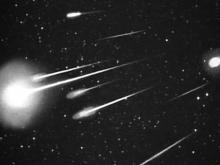Save the Dates: HamSCI Meteor Scatter QSO Party
Save the Dates: HamSCI Meteor Scatter QSO Party

HamSCI is preparing for a series of meteor scatter (MS) experiments later this year. The target storms are in August 11-12 (Perseids) and December 12-13 (Geminids). Preparation and testing are underway now. This is a combination 'special event' and a contest to generate contact data during meteor scatter events using 10 meters and 6 meters. A 'How To' guide and event rules are under development.
Ten meters has not been used much for meteor scatter study due to past symbol rate limits. But with recent changes in FCC rules, WSJT-X's MSK144 mode can now be used on HF bands. The HamSCI meteor scatter event will collect contact data from both 10 meters and 6 meters as part of the scheduled events in August and December. Data will be analyzed offline, comparing data from both bands, using both PSKReporter raw data and operator contact logs from WSJT-X. User data including both logged contact and received reports are necessary for valid experimental analysis. The latter can be provided by any receive system reporting on MSK144 through automated uploads to PSKReporter.
Currently, we need operators to be active (i.e., CQ-ing) on MSK144; or passive, if possible, reporting via PSK Reporter as 'monitors'. The best times are early morning hours prior to 10M opening to F2 propagation. Meteor scatter propagation occurs well below F2 and is supported in or near the E layer where the meteor ionization tracks occur. Saturday mornings are being used regularly to announce and coordinate 10M contacts using Ping Jockey Central. Announcements are also made on the Front Range Six Meter Groups.io listserv, due to the substantial number of meteor scatter operators in that group.
To be successful, this effort needs operators, both active and passive. The upcoming April-Lyrids shower is an excellent time to set up your equipment and join with other operators preparing for the events later this year. If you do not have the time to be active, at least set up passive reporting. PSK Reporter currently has scarce 10M MSK144 monitors; so we need to increase those numbers during the early morning hours.
The best Lyrid times are around local midnight and early morning hours, peaking April 21-22, but also for several days before and after the peak dates. We expect large numbers of 10M and 6M MSK144 operators to be both active and passive during the extended Lyrid events.
Specific information for the August and December special events will be published as it becomes available, and as the planning matures. The MSQP Operating Guidelines are under development.
Please join us in becoming both active and/or passive operator/participants in event planning during April. Eventually, the HamSci team will be collecting operator contact information, but for now, all that is required is for participants to report through PSKReporter.
Thanks to Bruce KN4GDX for the above. Anyone wishing to help define these events, generate 'how-to' documents, or assist with data analysis afterwards, please join the HamSCIENCE Zoom telecons on Thursday afternoons (4PM US Eastern Time Zone).
(Meteor image courtesy NASA / Ames Research Center / ISAS / Shinsuke Abe and Hajime Yano)
